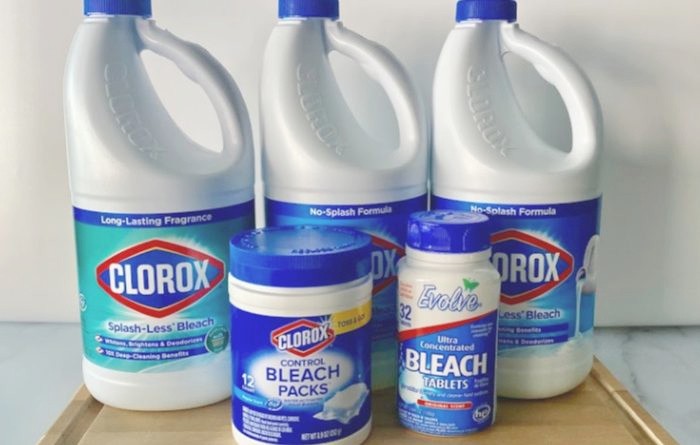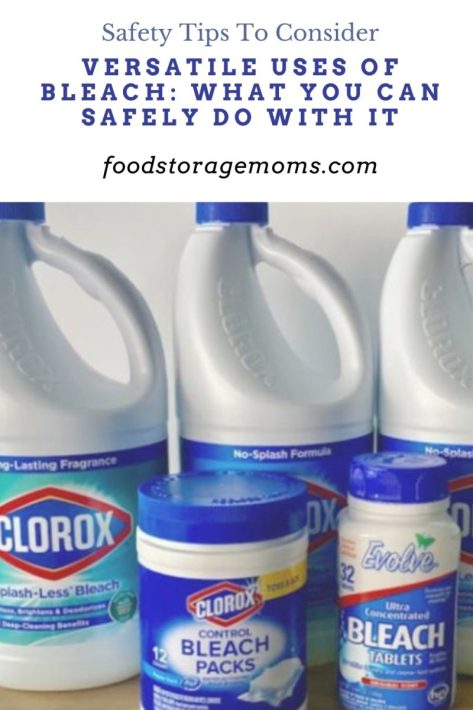
Bleach is one of the most powerful, affordable, and reliable household cleaners you can keep on hand. When used correctly, it disinfects, sanitizes, removes stains, and prevents mold. Here are the smartest, safest, and most versatile ways to use bleach around your home.
Preparing for emergencies and disasters requires careful planning, including gathering needed supplies. One item that often finds its way into a prepper’s toolbox is bleach. While commonly used for cleaning and laundry purposes, bleach also has many uses in emergencies. I like to keep bleach on hand because I know of its many versatile uses for prepping. Bleach: Everything You Need to Know
Shelf Life of Bleach
Please only store what you can use within 9-12 months. Clorox Bleach recommends replacing any bottle that is over 12 months old. Six months is the best storage time frame.

1. Water purification: Ensuring Safe Drinking Water
In a survival situation, access to safe drinking water is so important. Bleach can be an effective and accessible method for purifying water. Adding a few drops of bleach to contaminated water can kill harmful bacteria, viruses, and other microorganisms, making it safe for consumption. The general guideline is to add approximately eight drops (or 1/8 teaspoon) of unscented bleach per gallon of water, stirring well and allowing it to stand for at least 30 minutes before drinking. Why Drinking Water is So Critical to Our Health
Water Disinfection (Emergency Use Only)
When clean water is not available, you can purify it with unscented, regular household bleach (6–8% sodium hypochlorite). Use:
- 8 drops (⅛ teaspoon) per gallon of clear water
- Let sit for 30 minutes
If water is cloudy, double the amount.
2. Sanitizing surfaces and utensils: Maintaining Hygiene
Maintaining proper hygiene is crucial during emergencies to prevent the spread of germs and diseases. Bleach can be used to sanitize various surfaces and utensils. A bleach solution mixed with water can be used to disinfect countertops, cutting boards, cooking utensils, and other frequently touched surfaces. Mix one teaspoon of bleach with one quart of water for an effective cleaning solution. Why You Should Make Your Own Hand Sanitizer + DIY Recipe
Every time I cut raw chicken on my silicone cutting boards on one of my kitchen counters next to my sink, I want to make sure they’re clean afterward. I’ll use the unscented chlorine bleach I store in the laundry, mixed with water as described in section 1 above, to clean them. I keep some in a spray bottle so it’s handy and ready to go. We use this bleach solution all the time. I’ve used other homemade cleaning products made with vinegar, but this is the one I rely on.
I try to avoid using my wooden butcher’s block to cut raw meat because of its porous nature.
3. Disinfecting Outdoor Items
Bleach helps restore and sanitize:
- Patio furniture
- Coolers
- Gardening tools
- Play equipment
A simple 1:10 solution works for most outdoor surfaces.
4. Mold and mildew control: Avoiding Respiratory Issues
In damp and humid environments, such as during flooding or prolonged power outages, mold and mildew can quickly become a problem. Bleach is an effective tool for combating these issues. Mixing one cup of bleach with one gallon of water creates a solution to remove mold and mildew from surfaces. Remember to wear protective gear, such as gloves and a mask, when handling bleach and working in mold-infested areas. Keep in mind that this method only works on non-porous surfaces. What Would Mold Do To You?
The bleach solution can also be used to clean any mold that may have developed on the tile or grout in the shower or around the tub in the bathroom. Be sure to rinse the surfaces well with warm or hot water after your cleaning project. It also helps to clean any soap residue that may have accumulated from frequent use. A soft brush will come in handy for getting into tight corners and scrubbing the surface when necessary.
You can also use the solution to clean the ring from your toilets. Pour a small amount into the toilet bowl, let it sit for a few minutes, then use a toilet brush to clean the surface. Most toilets are safe from this application, but if you’re concerned, ask your plumber or plumbing distributor.
Bleach is highly effective at eliminating mold on non-porous surfaces, including:
- Shower tiles
- Grout
- Concrete
- Exterior siding
Spray a 1:10 bleach-to-water solution, allow it to sit for 10 minutes, then scrub and r
5. Laundry sanitation: Maintaining Clean Clothing
During emergencies, maintaining cleanliness becomes challenging. Bleach can be an excellent aid in keeping clothing clean and free from germs. Adding a small amount of bleach to the laundry cycle can help sanitize clothes, especially when dealing with contaminated items or when access to hot water is limited. How To Clean Your Laundry After A Disaster
Of course, we use bleach to remove stains in our clothes when used with proper fabrics in the clothes washer. We often forget that liquid bleach also kills germs on our clothes. Having an effective stain remover is always a good idea, whether in emergencies or for daily use. However, having one as a germ-killing agent is an added blessing.
Bleach brightens whites and removes tough stains like sweat, mildew, and food spills.
- Use regular bleach only on white cotton or polyester fabrics.
- Add ½ cup to the wash cycle (never pour directly onto clothes).
6. Disinfecting Hard Surfaces
In a survival scenario, it is crucial to keep tools and equipment clean and disinfected to prevent the spread of bacteria and diseases. Bleach can be used to disinfect gardening tools, cooking utensils, and other equipment. Create a bleach solution and soak the items for several minutes, rinse thoroughly, and allow them to air dry before use. Items That Work as a Disinfectant
Having a bleach dispenser like a spray bottle makes this chore much easier. I’ve found that it’s great to clean our grandkids’ toys too. Just make sure you have the right solution mixture. Also, be sure to put ingredient labels on the bleach dispenser so everyone understands what’s inside. Keep these products out of the reach of children; you don’t want any young kid to get harmed.
Bleach kills bacteria, viruses, and fungi on contact, making it perfect for:
- Kitchen countertops
- Bathroom sinks & tubs
- Toilets
- Cutting boards (non-porous only)
- Trash cans
How to use:
Mix one tablespoon of bleach per gallon of water for routine sanitizing. Let it sit on the surface for at least 1 minute before wiping.
7. Pest control: Keeping Pesky Insects at Bay
In an emergency, pests like mosquitoes, flies, and other insects can pose a significant threat. Using bleach as an effective insect repellent is a neat trick. Dilute bleach with water and spray it around doors, windows, and other entry points to deter insects from entering your living space. This is an essential tip for understanding the uses of bleach for prepping. Keeping Pests Away from Food Storage
What are the three recommended uses for bleach?
- Water purification – Adding a few drops of bleach to contaminated water can kill harmful bacteria, viruses, and parasites, making it safe for consumption. Water Storage: How Much Do You Really Need?
- Sanitizing surfaces and utensils – A diluted bleach and water solution can be used to disinfect countertops, cutting boards, cooking utensils, and other frequently touched surfaces. Why You Should Make Your Own Hand Sanitizer + DIY Recipe
- Laundry sanitation – Adding a small amount of bleach to the laundry cycle can help sanitize clothes, especially when dealing with contaminated items or when access to hot water is limited. DIY Laundry Detergent
8. Important Safety Reminders
- Never mix bleach with vinegar, ammonia, alcohol, or other cleaners.
- Use in a well-ventilated area.
- Store bleach away from heat and sunlight.
- Always dilute properly — more is not better.
- Wear gloves if you have sensitive skin.
What should I not clean with bleach?
- Wood and wood-based materials
- Pet products
- Metals
- Granite or marble surfaces
- Food-contact surfaces, particularly those with a porous surface
Final Word
There are many versatile uses of bleach for prepping. From purifying water to sanitizing surfaces and treating wounds, its uses for prepping are numerous. However, it is essential to handle bleach with care, following proper dilution ratios and safety precautions. Have you ever used bleach in any of these ways? If so, let me know in the comments section. Thanks for visiting today, and I hope this post was helpful. May God bless this world. Linda
Copyright Images: Bleach with Towels AdobeStock_297805436 By Lana Langlois
The post Versatile Uses of Bleach: What You Can Safely Do With It appeared first on Food Storage Moms.
from Food Storage Moms
No comments:
Post a Comment